Beverly Gray's Blog: Beverly in Movieland, page 17
March 1, 2024
The (Moon)Rising Career of Wes Anderson
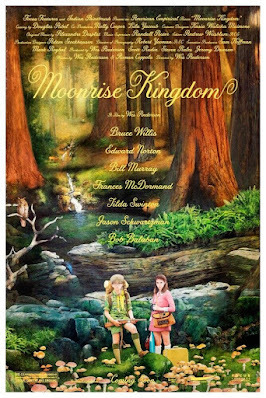
Wes Anderson’s directingcareer can be summed up in a single word: whimsy. The eleven features he’s made since 1996 areunique partly because of their skewed vision of the world we all know. His fansenjoy the idiosyncratic performances he gets from his informal stock company ofactors, which includes such big-name talents as Owen Wilson, Tilda Swinton,Adrien Brody, Frances McDormand, Jason Schwartzman, Edward Norton, AnjelicaHuston, the always amusing Bob Balaban, and of course Bill Murray. Then there’shis distinctive approach to set design: his visuals tend to make everythinglook just a wee bit artificial, as though the characters are living and workingin a giant dollhouse.
Anderson’s work is not toeveryone’s taste, and I admit that his droll , deadpan approach sometimesstrikes me as too much of a good thing. Asteroid City, for example, isso busy being spoofy about the threat of extraterrestrials and the productionof a theatre extravaganza that I gave up on trying to find a thread between thefilm’s various component parts. Anderson is at his best when he can find the heartof the matter: the human emotions connecting the artistically clever touches.
That’s what I like about2012’s Moonrise Kingdom. Yes, this island-set film has many of thefamiliar Anderson touches, like a cast of legendary faces, an oddball use ofmusic (here Benjamin Britten’s “A Young Person’s Guide to the Orchestra” isfeatured, played on a kid-sized portable record player), and a mischievous useof maps, letters, and other documents to tell the tale. There’s satire aplentyin Anderson’s look at a troop of Boy Scouts (led by Edward Norton and herecalled Khaki Scouts) who are working hard on their eccentric wilderness skills.Characters have funny jobs, or do their jobs in a funny—though sometimesgrotesque—way. (Bruce Willis is a local police chief embroiled in a secretaffair with one of the island residents; Tilda Swinton plays a straight-lacedsocial services officer who seems to be keen on electroshock therapy.)
But the chief focus of MoonriseKingdom is on two young people unwilling to learn the ways of their elders.Sam Shakusky and Suzy Bishop, are both about 12 and on the brink of puberty.Neither is at all comfortable with the adult world that seems to have no placefor them, and a chance meeting leads to a clandestine correspondence, and thena daring attempt to break away from civilization and live on their own, as asort of pint-sized Adam and Eve. (Suzy is rather taller than the clever butnerdy Sam, one of the film’s endearing details.)
Pretty soon everyone on theisland is engaged in the effort to find the missing pair, and then figure outwhat to do with them. The ending is about as quirky and happy as a Wes Andersonproject can be, leaving the viewer content that life—in all its craziness—willgo on. I love the fact that Anderson’s sometimes over-the-top visual ideas viefor attention here with the island’s natural beauty. (The scout troop’streehouse is an eccentric marvel.) I also love the sense that the story attimes mirrors some of the grand old tales we all know. Sam is, picturesquely,an orphan wanted by no one. And the scene of Suzy in the woods, reading fromone of her enchanting storybooks to a rapt circle of Khaki Scouts, seemsstraight out of Peter Pan. This is Anderson’s stab at a coming-of-agefilm. As the young characters find love, it’s easy for the viewer to fall inlove with them.
February 27, 2024
Mary Poppins Runs Afoul of the Language Police

The film Mary Poppins—theone starring Julie Andrews that was so much a part of my growing-up years—hasjust had its rating changed in Britain from U (for “universal”) to PG(“parental guidance“). At issue is what the British Board of Film Classification now considers “discriminatory language.” I was completelyflummoxed, at first, by the switch. It goes without saying that the original MaryPoppins series of children’s novels, published by P.L. Travers beginning in1934, contained racial stereotyping and language use that today make us squirm.(Travers herself later made some changes, though she resisted others, as apiece in yesterday’s The Telegraph makes clear.) But the 1964 Disney musicalextravaganza would seem at first glance to be as innocent as any movie couldbe, unless you consider Dick Van Dyke’s excruciating attempt at a Cockneyaccent a crime against humanity.
Van Dyke, though, is off thehook. At issue, it seems, are two references within the film to “thediscriminatory term ‘hottentots.’” Whichgave me pause: what exactly is a hottentot? Apparently this is a word firstused by the Dutch in South Africa to refer to an indigenous nomadic people,more correctly known as the Khoekhoe, who roamed the Cape region. For a time ithad some validity among anthropologists to refer to a specific ethnic grouping.And its comic possibilities led to its showing up in tongue-twisters and inpopular culture, including as part of a song lyric in The Wizard of Oz. (The Cowardly Lion asks, “What makes theHottentot so hot? What puts the 'ape' in apricot? What have they got that Iain't got?" The answer, of course, is “Courage.”)
But the fact that word’smeaning has ballooned to imply ignorant savages from the heart of the DarkContinent has apparently made it uncomfortable to use. This is why the British,well aware of their own history of racial and ethnic condescension, have seenfit to use the ratings change to warn parents. It’s not by any means a severepunishment, but it does suggest that words are a serious business, and thatit’s all too easy to overlook slurs from another era. Which reminds me of thecontroversy involving Disney’s 1941 animated feature, Dumbo. As Iunderstand it, the film was vilified for years because of a musical number inwhich a flock of crows led by a so-called Jim Crow perform a song that can beseen as stylistically reflecting the blackface minstrel entertainments of theOld South. It was critic Richard Schickel, in 1968’s The Disney Version,who loudly accused the studio of resorting to racist stereotypes in the way thecrows speak and move. (In recent years, a number of critics and movieperformers, including Whoopi Goldberg, have stuck up for the role of the crowsas parent-figures to the needy little elephant. They’re even the ones who teachhim to fly!) Today, Dumbo screenson Disney+ cable uncensored, but with a warning that the film “may containoutdated cultural depictions.” Disney’s 1946 Song of the South, though,continues to generate racial controversy.
Personally I shrink fromuncomfortably pejorative depictions of racial and ethnic minorities in bothfilms and literature. There’s a lot to cringe about in Hemingway and F. ScottFitzgerald, for instance, but I don’t believe that artistic works should berewritten to suit our modern sensibilities. (See current debates surroundingRoald Dahl’s writings for children.) Britain’s mild actions regarding MaryPoppins do seem appropriate, and I’m grateful to the British Board of FilmClassification for cluing me in to what a Hottentot actually is.
February 23, 2024
Sweets for the Sweet: “Wonka”
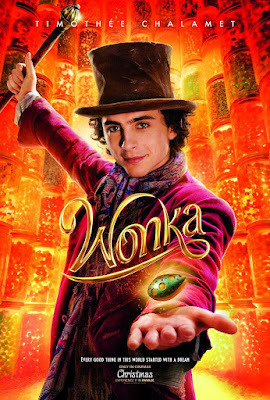
Timothée Chalamet, all of 28years old, has certainly been around. In 2017, barely 21, he rose tointernational fame as a lovestruck Italian teenager discovering his genderpreference in Luca Guadagnino’s Call Me By Your Name. The role broughthim an Oscar nomination for Best Actor, along with a raft of other honors, whilehe was also being feted as the “cool” boy who deflowers Saoirse Ronan’scharacter in Lady Bird, written and directed by Greta Gerwig..
He has also portrayed a drugaddict (Beautiful Boy, 2018), a young cannibal (Bones and All,2022), a revolutionary student (in Wes Anderson’s The French Dispatch, 2021),and—just for variety—the handsome young love interest in Gerwig’s adaptation ofLittle Women (2019) Very soonaudiences will be able to see him as heroic Paul Atreides in Part II of DenisVilleneuve’s adaptation of the science fiction classic, Dune.
But at the moment he’s busymaking chocolate. I’m talking about his starring role in the prequel toeveryone’s childhood favorite, Willy Wonka and the Chocolate Factory(1971). I suspect many of us have fond memories of Gene Wilder playing a matureWilly with bright blue eyes, flyaway hair, and an impish sense of humor. (And Isuspect most of us were turned off by Johnny Depp’s more sinister approach in2005’s Charlie and the Chocolate Factory, which bears the name of RoaldDahl’s original novel.) Movie franchisesbeing what they are, it wasn’t surprising that someone would decide the tale ofCharlie Bucket’s visit to the Wonka factory required a prequel. And so we getto find out, via Chalamet’s performance, just how the young Willy founded thatamazing factory in the first place.
Roald Dahl, of course, wasfamous for being curmudgeonly. A specialist in creating monsters of variousodious sorts, he tempered his sweet story about the magic of chocolate withsome very sour characters. The new Wonka does something of the same,with none other that Olivia Colman playing an evil landlady who keeps Willy anda clutch of other unfortunates in thrall, once they’ve had the misfortune ofspending a night in her seedy hotel. Her sardonic gloating over her victims issomething of which I suspect Dahl would approve. I’m much less sure he wouldhave liked the treacle in the story, like Willy regarding chocolate-making asthe legacy passed down to him by his dear, departed mother. (She’s played in several brief scenes bySally Hawkins, always a genuinely delightful performer with a heartbreakingsmile—but here asked to be part of a saccharine moment of magicalbeyond-the-grave reunion.)
The new film benefits from lots of fizzy and phantasmagoric visuals (oh, that giraffe!),in a charming European setting. I’m not sure, though, that it needed to be amusical. The various pleasant but not memorable songs (sung well enough byChalamet and others) simply make a longish film longer. There’s also lots oftime spent on building the backstories of some of the lesser characters. Awriter of my acquaintance wonders why, in today’s cinema, we can’t simplyaccept quirky characters for who they are, without giving them all past livesthat might possibly lead to sequels, thus broadening the Wonka Universe. Thiscomment made me think of a film with some similarities, Chocolat. In it,the past life of wandering candy-maker Juliette Binoche is left mysterious, andwe’re none the worse for that.
I can’t say enough, though,about Hugh Grant’s role as the drollest of Oompa-Loompas. Now that he’s too oldfor romantic roles, he’s sure enjoying letting his freak flag fly.
February 20, 2024
Giving Ted Lasso a Whirl

Yes, I know I’m a bit slow onthe uptake, but I just finished watching the second season of the hit TVseries, Ted Lasso. I suppose that if I really want to give the fullpicture of the Lasso saga, I should renew my subscription to Apple TV+ and gofrom there.
But the truth is that maybeI’ve seen enough. The third and final season definitely had its detractors, andby now I’ve got a pretty good idea of the quirks and quibbles of AFC Richmond,the British premier league football club (that’s soccer to us Americans). Thejoke, of course, is that Ted Lasso, the lovable coach of an American footballteam somewhere in the Midwest, has been hired—despite having zero experiencewith the sport—to lead an English soccer team. This happens mostly because theteam’s new owner, Rebecca Welton, is trying to get back at her philanderingformer spouse, who dotes on Richmond beyond all things.
But wouldn’t you knowit? Ted (vividly portrayed by showcreator Jason Sudeikis) is such a dang nice, dang optimistic fellow that heshakes off all the insults coming his way. Though he’s constantly beingridiculed by the locals as a “wanker” (the show is great on helping us enlargeour British slang vocabulary.), he boosts the players’ confidence in themselvesand pumps up team spirit, to the point where even Rebecca is on his side.
One of the show’s mostlikable qualities is its awareness of cultural differences. Not only do we seethe clash of British and American viewpoints but the team is also a lively mixof nationalities and ethnic backgrounds. The Richmond roster includes playersfrom all over Europe and Africa. Some of the most memorable include anenthusiastic young hombre from Mexico, a sweet-natured Nigerian who has atorrid secret romance with Rebecca in season 2, and a clever young Brit ofPakistani (I think) descent who is promoted by Lasso from kit man to assistantcoach, but loses his shy affability along the way. And the English charactersspeak in such a range of local dialects that Henry Higgins would have a fieldday: while watching this series I discovered the absolute importance of turningon subtitles so that I didn’t lose half the dialogue.
I must admit, though, that TedLasso becomes less fun as it movesalong. Since this is a cable show intended for on-demand viewing, episodes canbe of varying lengths, and they seem to stretch longer and longer as the seriesprogresses. And they also get more earnest, with every majorcharacter—including the amiable Ted—seeming to be hit by a big emotionalchallenge that must be explored. (In season two, a therapist becomes animportant character . . . and Ted finally reveals the immense family traumathat scars his past.) Then there’ssomeone’s hideously overbearing father, and several someones’ serious romanticwoes. Frankly, it’s a relief when the story shifts to the endearingly normal—ifslightly goofy—Director of Football Operations, one Leslie Higgins (JeremySwift), who is self-effacing without being neurotic.
The comparison is not exact,but I’m reminded of the last years of the great M*A*S*H. That was theera when popular network TV series ran for years, and M*A*S*H (1972-1983)lasted much longer than the Korean War it portrayed. By the end, everycharacter’s rough edges had been smoothed down, and every jerk had beenredeemed. The cast of misfit doctors and nurses had evolved into one big happyfamily. And what’s the fun in that?
February 16, 2024
Taking a Ride With My Cousin Vinny
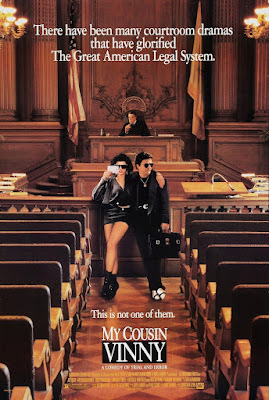
One delight of having alarge-screen TV and a cupboard full of DVDs is the ability to watch what youwant WHEN you want. On a recent evening, there was great tension in myhousehold, with a lot riding on a key phone call the following morning. (Thankfully,it all worked out.) It had been a miserably rainy day and evening, and we weredefinitely in need of some cheer. That’s when I pulled out a disk containingone of my all-time favorite funny movies: 1992’s My Cousin Vinny.
My Cousin Vinny is beloved by the legalprofession because its essential scenes take place in a court of lawwhere a novice attorney pleads a case before an old-school judge who’s astickler for correct behavior. (I’m told the film is an accurate depiction of courtroomprocedure and trial strategy.) Much of the humor comes from a clash ofopposites, and from the very different (and often incorrect) assumptions we allmake about the brash New Yawker and the Southern bumpkin. Two nice young men from the Big Apple, BillGambini and Stan Rothenstein, are driving Bill’s mint-green 1964 Buick Skylark convertiblethrough the Deep South en route to grad school at UCLA. In a rural town, theystop at the Sack of Suds to purchase some snack food. But shortly thereafterthey find themselves stopped by the local cops and arrested. Though at firstBill believes the cops have gotten wind of the can of tuna fish he accidentallyforgot to pay for, something far more serious is afoot. It seems the Sack ofSuds clerk has just been murdered during a hold-up by someone driving a mint-greenSixties-era convertible, and the two are the prime suspects. They’re innocent,of course, but what they desperately need is a attorney who can plead theircase in a town full of strangers.
Enter Vinny Gambini (theirreplaceable Joe Pesci), Bill’s uncle and a former garage mechanic who’s justpassed the New York bar on his sixth try. Riding shotgun in his souped-upCadillac is his plain-spoken fiancée, Mona Lisa Vito. Newcomer Marissa Tomeiwon an Oscar for this hilarious role: she wants to be helpful, because she’sbeen promised they’ll finally marry after he wins his first-ever case. ButVinny, who knows nothing about courtroom protocol, immediately alienates thevery staid Judge Chamberlain Haller, a Yale Law School graduate who demandsthat the dignity of the legal system be treated with respect. Judge Haller isplayed by the towering Fred Gwynne, a frequent TV presence in sitcoms like Car54, Where Are You? Sadly, he died shortly after the film’s release, butthis role—requiring him to be cunning yet fair-minded, indignant but oozingSouthern charm—was surely the highlight of his career.
Vinny’s struggles—to come upwith a court-worthy suit of clothing, to get a good night’s sleep in a townthat rises before dawn, to placate his fiancée’s growing petulance—are highlycomic. At first, as more and more details are brought forward, the task seemshopeless. But as the trial proceeds his native smarts are suddenly on display,particularly as he figures out how to cross-examine well-meaning eyewitnesseswho are too quick to see the out-of-towners as murderers. Eventually, Vinnyemerges victorious, but not without the help of someone who turns out to be farmore knowledgeable than we would have guessed.
It's nice indeed to see afilm about a culture clash in which no one on screen is a bad guy. And it’seven nicer when we find ourselves laughing all the way.
February 13, 2024
For Valentine’s Day and Beyond . . .”The Taste of Things”

Anatomy of a Fall is one of ten films in the running for the BestPicture Oscar. This twisty courtroomdrama, filmed in French, also copped four other nominations, including BestDirector (Justine Triet), Best Original Screenplay, and Best Actress (SandraHüller, also mesmerizing as the Nazi wife in The Zone of Interest). Onenomination that has eluded Anatomy of a Fall is for Best InternationalFeature. According to Academy rules, the candidates for this foreign-languagecategory must be nominated by their nation of origin, and no more than onenominee per country is permitted. The film folks of France, in their wisdom,chose not to so honor the very impressive Anatomy of a Fall. Insteadthey backed a romantic drama that is just now making the rounds in the U.S. ItsEnglish-language title is The Taste of Things.
If you watch The Taste ofThings, you’ll understand why it wonthe French seal of approval. It stars, first of all, the luminous JulietteBinoche, sometimes in the altogether. And it focuses on two subjects beloved bythe French populace: l’amour and la cuisine. This story of acircle of gourmands wining and dining in the nineteenth-century Frenchcountryside is full of witty chat about the joys of food, about how it would beeven more exciting to develop a brand-new dish than to discover a brand-newplanet. Food, in this narrative, comes before everything, even sex: marriage iswittily described as dinner and then dessert. For these characters, it’sperfectly logical that Adam ate an apple before discovering just what else Evehad to offer.
Here's the situation: Dodin, aclearly well-heeled landowner so passionate about food that (to hisembarrassment) he’s known in some circles as the Napoleon of gastronomy, has acomplicated relationship with his live-in cook, Eugénie.Together, in a kitchen entirely lacking today’s electrical appliances, theycraft fabulous meals that delight his circle of male friends. Eugénieknows she’s welcome to join these gatherings, but she seems radiantly contentto keep to her place in the kitchen, enjoying the labors of food preparationand the hearty satisfaction of their guests. At times she also welcomes Dodinas a bedmate, but continues to make it clear that she will not marry him, thatshe requires the right to her own solitude, when she so chooses.
Nonetheless, these two arebound together so tightly, thanks to their mutual passion for food and foodpreparation, that it seems impossible to imagine them ever completely apart. Acurious sidenote: lead actors Binoche and Benoît Magimel were romanticallyinvolved for five years early in this century. They welcomed a daughtertogether, but later moved on. In the film, though the relationship faces amoment of parting, love survives in a mysterious but truly appropriateway.
I have no idea what kind of cook Binoche mightbe in real life. But the camera captures her (and Magimel) deftly crafting themost simple but elegant of dishes. She smiles beatifically while crimping acrust, decorating a cake, surveying her garden produce, or watching the delightof a smart child who appreciates the subtle ingredients of her broth. There’ssomething earthy about her that suits this role, and I recall a similar pairingof Binoche and delicious flavors in Chcocolat. In that lovely English-languagefilm, directed in 2000 by Lasse Hallstrōm, she played a rather magical maker ofconfectionary delights that transform the malcontents of a small French towninto happy hedonists. If you’ve ever wondered about the link between Binoche’sbeauty and a just-ripe pear, this is the film for you.
February 9, 2024
Orphans in and out of the Storm
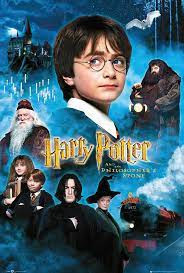
There’s something poignantand (let’s face it) picturesque about orphans. The idea of a child movingthrough the world without the loving embrace and guiding presence of parents issad indeed. But many of us tend to believe that children who lack one or bothparents make up for this loss by being that much smarter, pluckier, andstronger than their better-endowed peers. In the end, these kids are the heroesof their stories: at least, that’s the way it works in Grimms’ Fairy Tales and manynovels. Just think of what Charles Dickens has written, in works like GreatExpectations and Oliver Twist. His motherless, fatherless boysultimately emerge (after many disturbing adventures) triumphant, as doesCharlotte Brontë’s Jane Eyre. And it’s not merely a 19th centuryphenomenon: let’s not forget one of the most famous, most ultimately powerful,orphans of them all—Harry Potter. a
A colleague of mine, attorneyMarlene Trestman, became (to her own surprise) a biographer when she published FairLabor Lawyer: The Remarkable Life of New Deal Attorney and Supreme CourtAdvocate Bessie Margolin. Marlene, from New Orleans, had the misfortune tolose both her parents by the time she was eleven. Fortunately for her, theJewish Children’s Regional Services saw to her needs, eventually connecting herwith foster parents she still regards with deep familial love. She grew up wellaware that the building at the intersection of St. Charles and Jeffersonavenues where she received social services had at one time been the venerableJewish Children’s Home. The Home, founded before the Civil War, hadwelcomed Jewish orphans from all over the American South, including the smartand talented Bessie Margolin. Its history became Trestman’s new writingproject, Most Fortunate Unfortunates: The Jewish Orphans’ Home of NewOrleans.
What does all this have to dowith movies? I asked Marlene whethermoviegoing played any part in the lives of the orphans housed at the Home inits early days. Here’s what she wrote back: “Superintendent Leon Volmer (who wasan early adopter of the newfangled technology of motion pictures) reported tothe board in August 1916 about the movies he screened in the Home (with adonated film projector): ‘The bi-weekly picture shows are not only a thing ofbeauty and joy to the children but are also very beneficial educationally . . .We have some exceptionally fine pictures, such as The Children of the Ghetto,Wanted A Home, The Foundling, and Nature Studies. Suchpictures not only broaden the mental horizon of the children but strengthentheir moral vision and are an attractive yet powerful aid in the characterbuilding of children.”” Marlene notes that in the sentence aboutcharacter-building, “Volmer may have been referring to the fact that loss ofmovie privileges provided a sure-fire method to curb misbehavior!”
Latertoo the orphans were treated to entertainments about kids like themselves whoseparents were dead or missing. In 1918, they saw an actual live play, Pollyanna, with aseventeen-year-old Helen Hayes as the “pluckily cheerful orphan girl” whospreads joy wherever she goes. (This sappy perennial was to become a moviefavorite. It starred Mary Pickford in 1920 , while Hayley Mills played the rolefor Disney in 1960.) The Home organized a special movie outing in 1919 to seePickford play yet another orphan in Daddy Long Legs. In 1922 theywatched what sounds like Orphans of the Storm, starring Lillian and Dorothy Gish as waifs survivingthe French Revolution. If you have the misfortune of being orphaned, I guessit’s encouraging to know you’re not alone.

February 6, 2024
Ghosts in the Machine: The Zone of Interest

I didn’t really want to see TheZone of Interest. A movie set in the stately home of the Nazi overlord ofAuschwitz hardly seemed like a lot of fun. Still, the awards for this German-languagefilm—shot near the Polish burg where the events actually happened—keep oncoming. There are five Oscar nominations, including Best Picture. Britishfilmmaker Jonathan Glazer is up for Best Director and Best Adapted Screenplayfor this project, to which he has devoted his life for the past decade.
For me watching The Zoneof Interest was a matter of chance. I had a pass to see a new sciencefiction film set in Outer Space. But when I arrived at the theatre on a quietweekday night, all the seats to the special screening were taken. That left mewandering the multiplex, aware I could duck into any auditorium withoutcreating problems. And The Zone of Interest was starting in less thanfifteen minutes. The universe seemed to be telling me something.
I guarantee I don’t want to re-watchThe Zone of Interest anytime soon. But that doesn’t take away from thedazzling filmmaking I saw on screen. Everything in the movie is meant tounsettle the viewer, from the ominous dark screen that lingers at the beginningto the eerie soundtrack, intended to remind us that on the other side of thegarden wall from the Hōss family’s comfy digs are the crematoria in whichthousands of Jews are daily being sent to their deaths. We never see thevictims, but it’s impossible to forget about them. Early in the film, Frau Hōssreceives a bundle from a local man. In it is a full-length fur coat that shetries on, admiring herself in a mirror. She digs a lipstick out of a coatpocket, checking that out too. It’s clear to us, though the words are neverquite spoken, that the coat was ripped off one of Auschwitz’s Jewish victims. Frau Hōss accepts it with equanimity,perfectly satisfied with the facts of her life: her children, her garden, hersubservient domestic staff, her husband with his snug Nazi uniform and tall,shiny boots.
Husband Rudolf (an actualhistorical figure) seems at first glance nicer than his chilly wife. He doteson the five kids, for one thing, and loves fishing in the local river, until hecomes upon something ominous that we suspect is human remains. Otherwise he’sbusy playing politics with regard to his superiors, is seen counting a verylarge pile of cash, and (as is suggested in an eerie scene) has been having hisway with one of the local housemaids. Late in the film, he returns to Headquarters to be feted and given a higher position. At an elegant soiree in amagnificent ballroom, he climbs to the balcony and looks down on all thebeautiful people below. Then, in a late-night phone call, he tells his wifethat he fantasized about the effort it would take to gas them all, given thechallenges of the room’s high ceiling.
That’s one way in which wesee the Nazi outlook shaping those who accept it. In a movie that alwaysremains low-key, we also watch one of the Hōss sons cheerily lock his littlebrother in the family greenhouse, enjoying the terror he’s creating. And thereare mystery moments when the ghosts of the dead seem to be walking. I was gladto leave this world and retreat to a nearby café where FrankCapra’s delightful It Happened One Night was playing out on a blankwall. Phew!
February 2, 2024
Bye, Bye, Chita (Rivera)

Believe me, though I struggleeach week to find appropriate topics for my Beverly in Movieland blog posts, I’mnot thrilled when performers I admire pass to the Great Beyond. Even whenthey’ve lived long, full lives, it’s sad to think that they’ll be among us nomore.
One shining star who has justleft us is the magnificent Chita Rivera, known as a dancer, a singer, anactress, and an all-around grand lady of the American stage. Rivera, one offive children born to a Puerto Rican father and a multicultural mom, discoveredher love of showbiz early. Trained in dance, with a scholarship to GeorgeBalanchine’s School of American Ballet, she soon gravitated toward the brightlights of Broadway. Before she turned 20 she was dancing in touring companiesof hit shows, and made her Broadway debut in Guys and Dolls. In 1957came her breakthrough role: that of the fiery Anita in West Side Story. Herreviews were glowing, though she was not nominated for a Tony, and the BestMusical honors went to another of the year’s hits, The Music Man. (Thiswas an era with a lot of great shows on the Broadway boards.)
Another disappointment: in1961, when West Side Story was turned into a film, the role Rivera hadcreated on stage went to a different fiery Latina, Rita Moreno, who went on towin an Oscar for her performance. (On screen, the role of Anita seems to be anawards magnet. Though Steven Spielberg’s 2021 remake of the film was nominatedfor seven Oscars, the only winner on Oscar night was the actress playing Anita,Ariana DeBose. A sidenote: in the remake, Spielberg gave Moreno a juicy newsupporting role as Valentina, the widow of drugstore owner Doc, who gets tosing “Somewhere” at a key moment in the film.)
I’ve always wondered whyRivera was not asked to repeat her Broadway role. Age had nothing to do withit: Moreno was actually a year older. I’m hardly privy to any behind-the-scenesgossip, but have always suspected the choice was made because Moreno (aHollywood veteran who had played supporting roles in Singing in the Rain andThe King and I) was equally talented AND a great deal prettier than herBroadway counterpart.
In any case, Rivera recoupedon Broadway as the female lead in Bye Bye Birdie, opposite Dick VanDyke. Her character, Rose Alvarez, was specifically written as a Latina (whichis one reason Dick’s stage mother disapproves of her so heartily). When theplay became a movie, Van Dyke was invited along, but Rivera’s part was taken byJanet Lee in a dark wig. Ah, Hollywood! Fortunately, though, we do have someRivera performances on film. She had played Gwen Verdon’s pal, Nickie, in thestage version of Sweet Charity. In 1969. when Bob Fosse directed the filmversion, Verdon was replaced by Shirley MacLaine as the taxi dancer with aheart of gold. And Rivera (hooray!) againgot to play Nickie, displaying her musical talents along with MacLaine andPaula Kelly in the clip below.
She finally won a Tony Awardin 1993 for a phantasmagoric role in Kander and Ebb’s musical take on Kissof the Spider Woman. I don’t much remember that, but I’ve hardly forgottenher 2015 appearance in the short Broadway run of Kander and Ebb’s eerie TheVisit. At 82, she didn’t exactly dance, but her performance was stunning. Iwatched it along with my own first dance teacher, the great Carmen deLavallade. It’s one of my favorite memories.
It’s been a tough week forBroadway fans. On January 30 we also lost Hinton Battle, a Tony-winningfeatured dancer best known for creating the role of the Scarecrow in Broadway’sThe Wiz, which—by the way—was directed by Carmen de Lavallade’s talented husband,Geoffrey Holder.
January 30, 2024
Remembering Norman Jewison
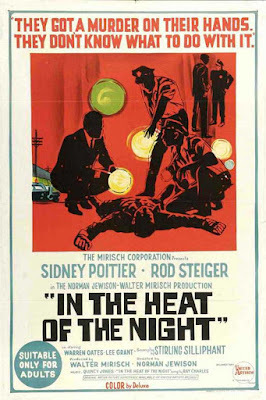
When I was a graduate studentat UCLA, leading introductory literature classes, I was surprised by the numberof celebrities’ kids who showed up on my roster. One was the son of CharltonHeston, who brought in to show me his father’s prized first edition ofHemingway’s cryptic story collection, In Our Time. One was the pretty,wholesome daughter of handsome, wholesome singer Pat Boone. One was KevinJewison, a pleasant young man who turned out to be the son of film directionNorman Jewison, the Oscar-winning director who just passed away at the ripe oldage of 97.
Looking back at Jewison’slong career, I was struck by how varied it was. Jewison, one of those famously“nice” Canadians, was born and raised in Toronto, and entered the entertainmentworld via Canadian television. That led him to NBC, where he seems to have beentypecast as the director of innocuous musical specials, like The ChevyShowroom Starring Andy Williams (1959) and Bulova Watch Time withPat Boone (1961). He also had the opportunity to work with suchnotable talents as Danny Kaye, Harry Belafonte, and Judy Garland, beforepivoting into film. Following some innocuous Doris Day romantic comedies, hefound more of a challenge working with Steve McQueen in 1965’s TheCincinnati Kid, a tough-minded film about serious poker players and thewomen who love them. The next year, he released The Russians Are Coming, TheRussians Are Coming, a timely Cold War satire –about a Russian submarinerunning aground off the New England coast—that made a comic star out of AlanArkin. It led to four Oscar nominations, including Best Picture and Best Actor:I found it absolutely delightful at the time, but less so when I re-watched itdecades later.
In 1968, Jewison was back atthe Oscars with In the Heat of the Night, a tight and tidy drama aboutracial tension in a small Southern town following a murder. The fraughtinterplay of the town sheriff (played to a fare-thee-well by Rod Steiger) and aBlack big-city cop (Sidney Poitier) was brilliantly acted under Jewison’sdirection. At a time when interracial tension was very much on the public’smind, the film was nominated for five Oscars. It won four, including BestPicture, Best Actor (the much-deserving Steiger), and Best Screenplay (a vastimprovement over the clumsy novel on which it was based). But Jewison lost toMike Nichols of The Graduate in the Best Director category.
In 1972, Jewison (who had topatiently explain to reporters that despite the implications of his name he wasNOT Jewish) produced and directed a creditably gritty screen version of thebeloved stage hit musical, Fiddler on the Roof. He followed up withsomething completely different, the film translation of Jesus ChristSuperstar. Then came the violent and futuristic Rollerball (whichindirectly led –as I well remember—to Roger Corman’s Death Race 2000), anda series of powerful films about social injustice. But his last really hugehit, leading to another Best Picture Oscar and another Best Directornomination, was a charming romantic comedy, 1987’s Moonstruck. Though he was nominated three times for the BestDirector Oscar, he was fated never to win that prize. But the Academy did granthim in 1999 the coveted Irving Thalberg Award, in honor of his role as one ofHollywood’s most creative producers, alongside such industry masters as BillyWilder, Francis Ford Coppola, and Steven Spielberg.
And son Kevin, my amiableformer student, became a motion picture cameraman, whose credit I just noticedon Sleepless in Seattle.
Beverly in Movieland
- Beverly Gray's profile
- 10 followers



